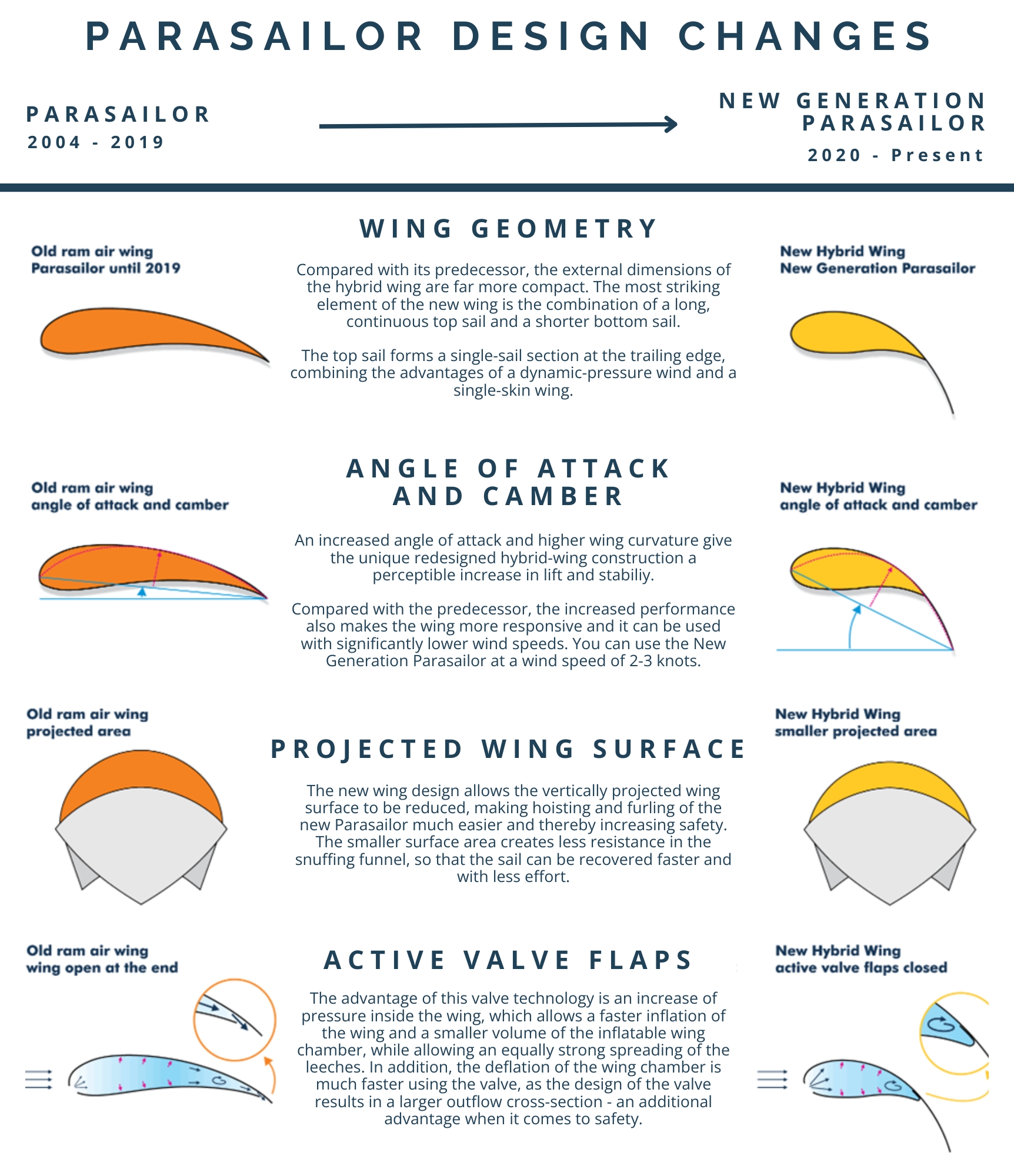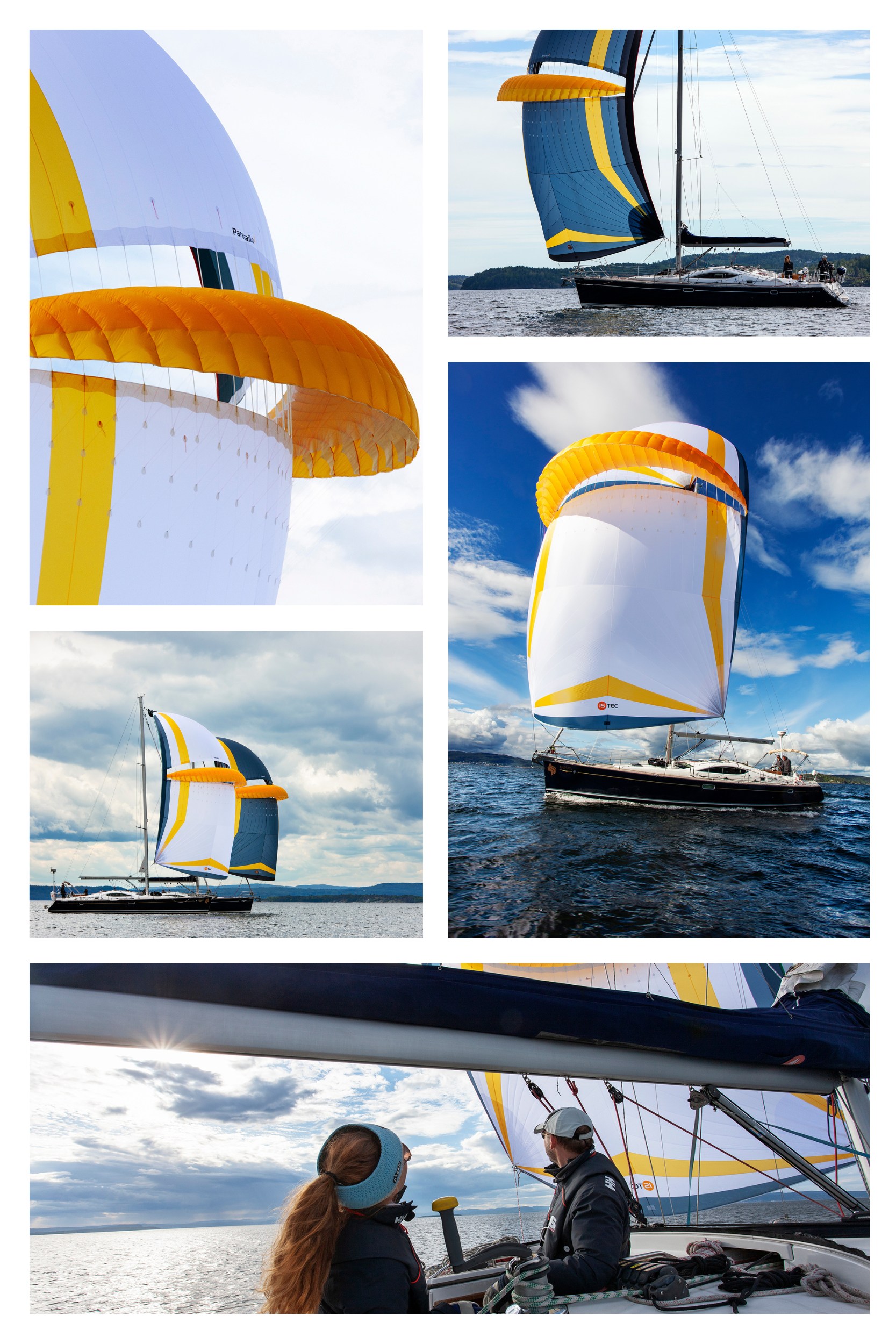Are you ready to FLY AWAY?
The spinnaker with a wing for safe and easy downwind sailing
As we began to plan our must-haves for an Atlantic crossing, we realized that a fool-proof sail for light to moderate conditions was at the top of the list. We considered a traditional spinnaker, but know from past short-handed offshore experience that we are wary to hoist one in all but very light wind. We needed something that was easy to handle, more forgiving to gusty conditions, and that could be used on various points of sail.
The Parasailor has been on our radar for years and as we explored the many advantages, we became hooked on the concept. So much so that we approached ISTEC (parent company) to buy our own sail and for Hydrovane to become a Parasailor dealer!
– Will and Sarah Curry
ADVANTAGES OVER TRADITIONAL DOWNWIND SAILS
♦ A Parasailor alone is an excellent replacement for at least two classic downwind sails. It is two sails in one!
♦ The Parasailor works from 70° to 180° apparent wind angle (AWA). In other words, it covers the range of both symmetric and asymmetric spinnakers combined, with truly innovative qualities
♦ As the sail fills, air passes above and underneath the wing which generates high and low pressure (much like the wing on an aircraft). This creates lift which raises the bow. Speed and performance noticeably increase (bow has less resistance to overcome), roll and pitch also dramatically decrease making for a smoother, safer and more comfortable sail. This effect is particularly pronounced on catamarans.
♦ The air-filled pockets of the wing give the Parasailor far more stability than any traditional spinnaker or cruising chute.
♦ No need to use a pole. Not having to rig a pole is a huge advantage for short handed crews. Without a pole you can safely gybe the Parasailor from the cockpit without having to go to the foredeck.
♦ The Parasailor needs only four lines to fly (2 sheets, 2 downhauls) and can be controlled entirely from the cockpit once hoisted.
♦ Its structure allows it to cope with hard gusts much better than regular spinnakers. The horizontal opening is a true safety vent, allowing a sudden and strong increase in air pressure to exit the sail in a controlled manner.
♦ Can be used significantly earlier at low wind speeds. Be ready to hoist the new generation Parasailor at a wind speed of 2 to 3 knots, depending on the course.
♦ Made in Europe with materials from Europe, your new Parasail will always be a faithful and sturdy companion.The combination of high-quality materials and careful workmanship guarantees an extremely robust product.
You’re not at the sheet and guy the whole time, something that really suits a lazy crew. I often set the Parasailor without the pole and just use it like a normal asymmetric. I’d recommend the Parasailor to anyone thinking about buying a new spinnaker.
– Jimmy Cornell, sailing icon and author, UK
THE WING
The wing is the distinguishing feature and reason why the sails are so well-mannered.
A tailwind fills the sail and propels the yacht forward (advance). Part of the pressure escapes through the opening in the sail behind which the wing has been fitted in such a way that the air flows past above and below it. Thanks to the shape of the wing and the angle at which the air flows towards it (with the angle optimized for efficiency), the air on the surface of the wing accelerates faster than the air beneath it. Low pressure then forms on the surface which literally sucks the wing upwards and stabilizes it (lift).
The wing lift achieves two essentials effects: Firstly, pressure on the bow is reduced. And secondly, propulsion is increased because the wing’s optimized angle of efficiency is designed so that the loss of propulsion caused by the opening is completely compensated for.
All wings are not equal. The redesigned patented hybrid wing as seen on the New Generation Parasail noticeably increases performance compared with the previous Parasailor model. To better understand those qualities, please see review DESIGN CHANGES below.


VIDEO: NEW GENERATION PARASAILOR
VIDEO: PARASAILOR AND HYDROVANE
Questions We Asked
What surface area sail is correct for my boat?
The required sail area is determined by the ‘I’ or ‘ISP’ measurement of your boat’s mast. It is likely we have this measurement in our database and if not we will provide instructions to measure. We will provide a quote with the correct size sail for your boat.
My husband and I sail double handed. Is there a benefit to using a slightly smaller sail?
There in no reason to do so. In fact, we recommend against it for two reasons. Firstly, the sail will fly higher than intended, which gives it a less stable shape. Secondly, because it is flying higher (and looks silly!), the tendency is to compensate by pulling down. This strains the leeches and can increase the chance of a blow out.
Can I choose the colour blocks and add my boat’s logo?
Absolutely. The Parasailor and Parasail each have standard design options (please see the DOWNLOADS section at the end of this page). Additional costs apply to play with the colours and/or add a logo, but customization makes your sail truly unique. We are happy to provide options or work with your own design.
What is the difference between the New Generation Parasailor and the Parasail?
In a nutshell: a newly designed patented wing for the Parasailor (since 2019) makes it the most effective and technologically advanced spinnaker available on the market. The Parasail uses an older single sing wing design (no air pockets), but is still an excellent cost-effective option.
Can I continue to use my autopilot or Hydrovane while under Parasailor?
Yes. Electronic autopilots and the Hydrovane are both influenced by boat balance. The Parasailor and Parasail will increase stability, reduce roll, and are not as reactive to gusts as a traditional spinnaker would be. The Parasailor does not need constant trimming so you may find you have your hands to yourself more often!
Should I use my mainsail as I do with a regular spinnaker?
It’s up to you, but there is no reason to use your mainsail,
What is the lead time to receive my Parasailor?
Every sail is made to order. Lead time is typically 4 – 8 weeks from deposit date, but we can assist with more urgent orders too.

QUOTE REQUEST FORM
Please provide the below information and we will be pleased to send a quote and details applicable to your boat.
